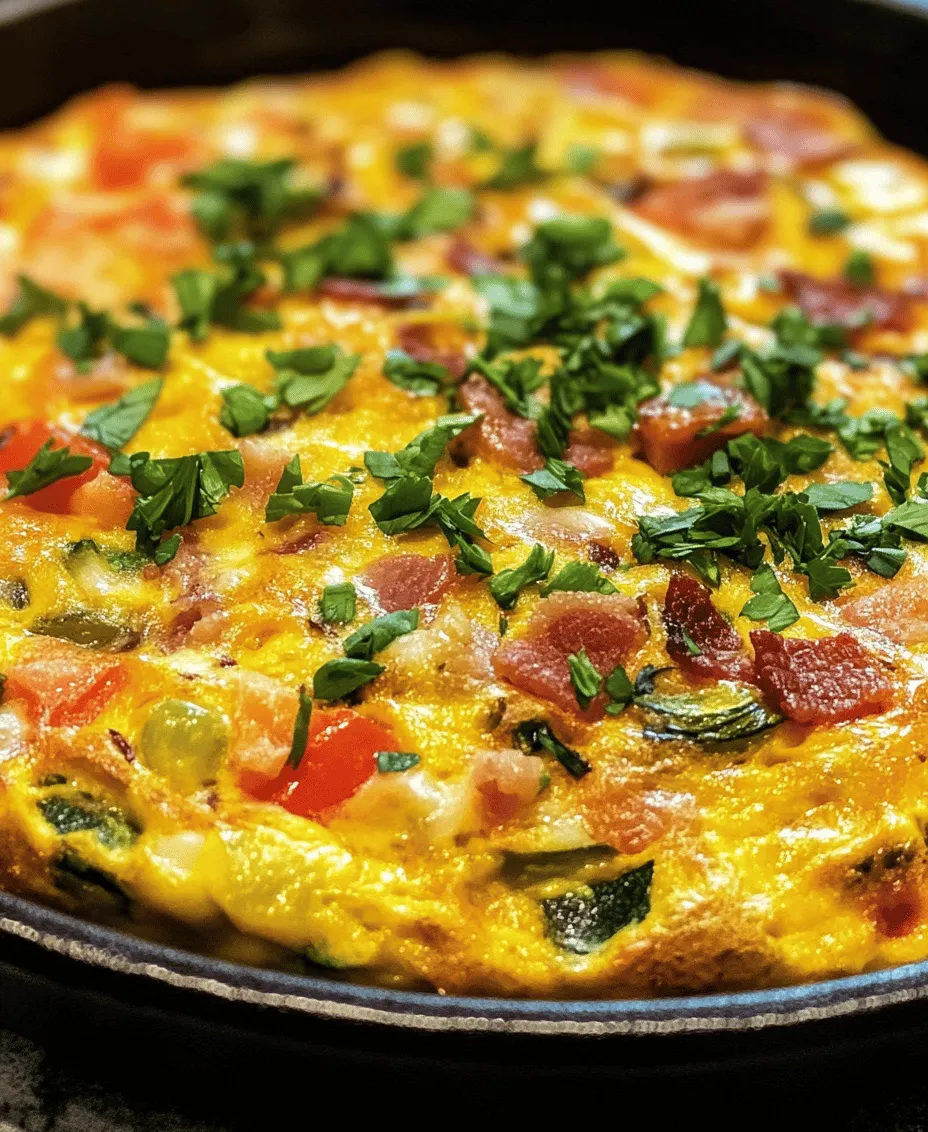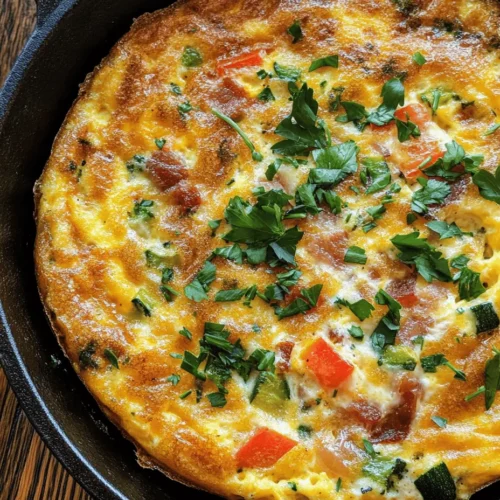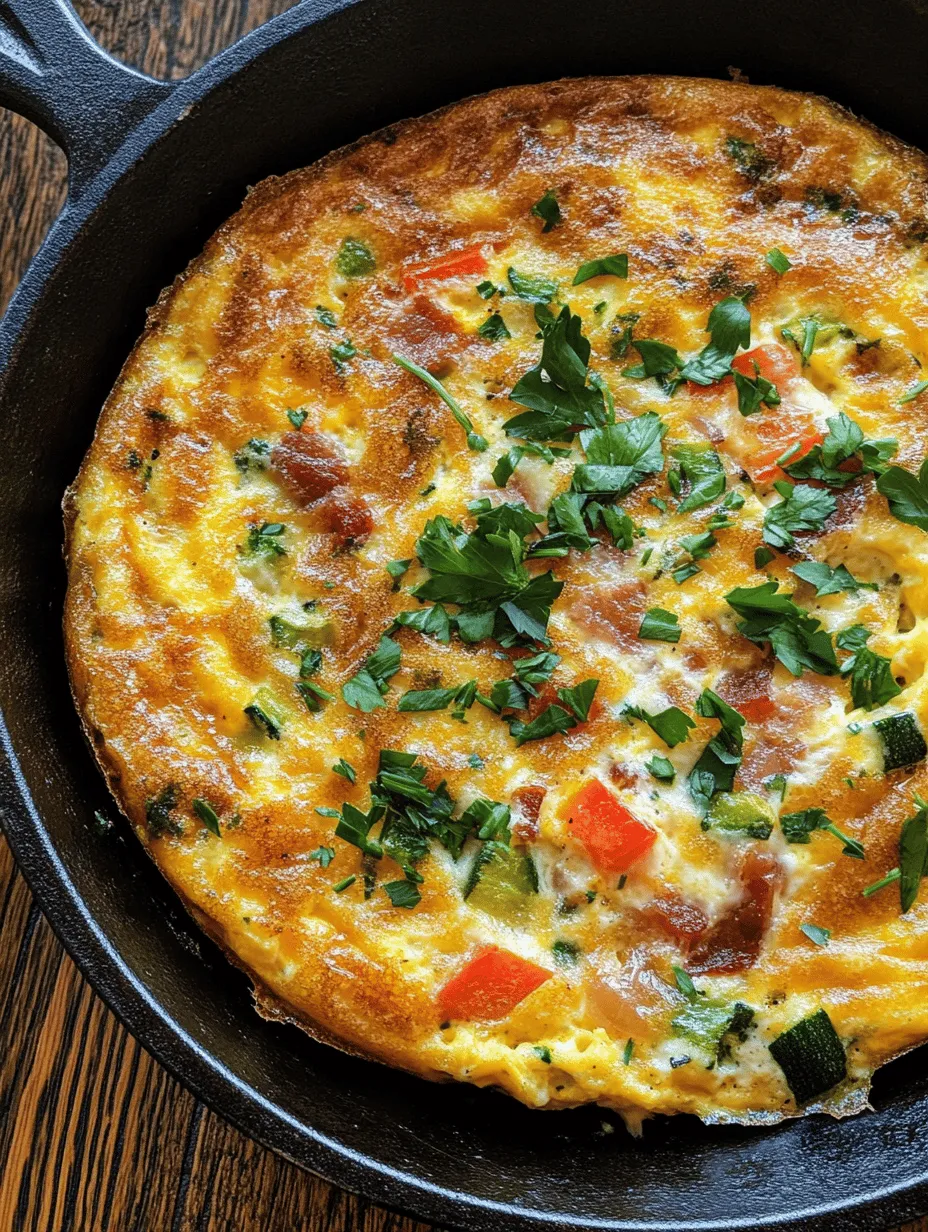Introduction to the Perfect Frittata
The frittata stands out as one of the most versatile dishes in culinary traditions around the world. Whether enjoyed for breakfast, brunch, or a light dinner, this Italian classic offers an inviting canvas for a multitude of ingredients. Its ability to adapt to different flavors and dietary requirements makes it a staple in many kitchens. From vegetarian options bursting with seasonal vegetables to heartier versions featuring meats and cheeses, the frittata is a dish that caters to everyone’s tastes.
The foundation of a perfect frittata relies heavily on fresh ingredients. The quality of your vegetables, the richness of the eggs, and the flavor of any additional components can make a significant difference in the final outcome. Fresh, local produce not only enhances the dish’s flavor but also contributes to a vibrant presentation. As you embark on your frittata-making journey, remember that the essence of this dish lies in its simplicity and the quality of its ingredients.
Moreover, the frittata is not just limited to traditional ingredients; its adaptability makes it an excellent choice for various dietary preferences. Whether you’re a vegetarian, a meat lover, or someone looking to eat gluten-free, the frittata can be easily customized to suit your needs. This feature not only broadens its appeal but also encourages creativity in the kitchen. With a little imagination, you can transform a basic recipe into a personalized masterpiece that reflects your culinary style.
Understanding the Frittata: An Italian Classic
To truly appreciate the frittata, it’s essential to understand its origins and how it compares to similar dishes. The term “frittata” comes from the Italian word “friggere,” meaning “to fry.” Traditionally, a frittata is made by mixing beaten eggs with various fillings and then cooking it slowly over low heat. Unlike omelets, which are typically folded over their fillings, frittatas allow for a more even distribution of ingredients throughout, creating a cohesive and flavorful dish.
Frittatas also differ from quiches, which have a pastry crust and are usually rich and creamy due to the addition of milk or cream. In contrast, the frittata is crustless, making it a lighter option that showcases the eggs and fillings without overwhelming them with a heavy base. This simplicity is part of what has made the frittata so popular across diverse cultures, from Italian trattorias to modern brunch spots.
The frittata has found its way into various cuisines, each adapting the dish to local tastes and traditions. In Spain, for example, the “tortilla Española” is a beloved version that features potatoes and onions. In Middle Eastern cuisine, similar egg dishes incorporate spices and herbs unique to the region. This widespread appeal speaks to the frittata’s cultural significance and its ability to resonate with different palates.
Essential Ingredients for a Perfect Frittata
Creating the perfect frittata begins with selecting the right ingredients. While the base of the dish is eggs, the choices you make regarding the additional components can elevate your frittata to new heights. Here’s a breakdown of the essential ingredients that contribute to a delicious and satisfying frittata.
Eggs: The Star Ingredient
The quality of the eggs you choose is paramount. Fresh eggs not only provide superior flavor but also contribute to a rich, vibrant color in the final dish. When possible, opt for free-range or organic eggs, as they tend to have more robust flavors and higher nutritional value. The freshness of the eggs can significantly enhance the overall taste of your frittata.
Dairy Options: Milk vs. Cream
Another key component is the dairy you choose to incorporate. While some recipes call for milk, others prefer cream for a richer texture. Milk can lighten the dish, making it fluffier, while cream adds a luxurious creaminess that can be particularly satisfying. Consider experimenting with both options to find the balance that best suits your palate. For a lighter frittata, stick with milk; for a more indulgent version, opt for cream.
Choosing the Right Cheese
Cheese plays a pivotal role in frittatas, adding depth and flavor. The type of cheese you select can dramatically impact the dish’s taste profile. Classic choices include feta, goat cheese, cheddar, or Parmesan, each imparting its unique character. Soft cheeses like goat cheese melt beautifully, while aged cheeses like Parmesan add a savory note. When selecting cheese, consider how it will interact with your other ingredients and choose one that complements their flavors.
Seasonal Vegetables: Selection and Preparation
Vegetables are another essential component of a frittata, allowing you to incorporate seasonal produce and enhance the dish’s nutritional value. When preparing your frittata, aim for a variety of colors and textures. Good options include bell peppers, spinach, zucchini, asparagus, and mushrooms. Be sure to wash, chop, and sauté your vegetables before adding them to the egg mixture, as this helps to develop their flavors and ensures they’re cooked through.
Optional Meats: Elevating Flavor
If you prefer a heartier frittata, consider adding meats such as bacon, ham, or sausage. These ingredients can introduce a savory richness that pairs beautifully with the eggs and vegetables. When using meats, it’s best to cook them in advance to ensure they are fully cooked and crispy before adding them to the frittata mix. This step not only enhances their flavor but also adds a satisfying texture to the final dish.
Herbs and Spices: Adding Depth
Finally, don’t underestimate the impact of herbs and spices in your frittata. Fresh herbs like parsley, chives, or basil can brighten the dish and add a burst of flavor. Alternatively, dried spices such as paprika or black pepper can enhance the overall taste profile. A pinch of salt is essential to bring out the flavors of your ingredients, so be sure to season your mixture well.
Preparation Steps: Crafting Your Frittata
Now that you have a clear understanding of the ingredients, it’s time to dive into the preparation steps that will lead you to a perfect frittata. Following these guidelines will ensure that your frittata is fluffy, flavorful, and visually appealing.
Preheating the Oven: Why Temperature Matters
Before you begin cooking, preheat your oven to 350°F (175°C). This ensures that your frittata will cook evenly and thoroughly. The transition from stovetop to oven is crucial for achieving that perfect texture—cooking the frittata in the oven allows it to set gently without overcooking or browning too quickly.
The Art of Whisking: Ensuring a Fluffy Texture
The next step involves whisking your eggs. This process is essential for incorporating air, which will lead to a light and fluffy frittata. Whisk the eggs vigorously until they are well combined and slightly frothy. For an extra creamy consistency, you can add your chosen dairy at this stage. The goal is to achieve a homogenous mixture that will provide a uniform texture throughout the frittata.
Incorporating Ingredients: Tips for Even Distribution
Once your egg mixture is well-prepared, it’s time to incorporate your chosen ingredients. Start by mixing in the sautéed vegetables, meats, and cheeses. It’s important to ensure that these ingredients are evenly distributed throughout the egg mixture for consistent flavor in every bite. Use a spatula to gently fold the ingredients into the eggs, taking care not to overwork the mixture.
The Skillet Technique: Importance of Using an Oven-Safe Skillet
Choosing the right skillet is pivotal for a successful frittata. An oven-safe skillet, such as cast iron or a non-stick option, is ideal for this dish. These skillets retain heat well and provide even cooking, which is essential for a perfectly set frittata. Add a little olive oil or butter to the skillet and heat it over medium heat before pouring in your egg mixture.
Cooking on the Stovetop: Key Signs for Readiness
As the frittata cooks on the stovetop, keep an eye on it to ensure it begins to set. You want to cook it until the edges firm up but the center remains slightly jiggly—this is a sign that it’s ready to transfer to the oven. Typically, this process takes about 5 to 7 minutes. Once you see this texture, it’s time to place your skillet in the preheated oven to finish cooking.
—
These preparation steps set the stage for creating a perfect frittata, ensuring that your dish is both flavorful and visually appealing. The culinary journey into the world of frittatas is rewarding, allowing for endless creativity and satisfaction in each bite. With this foundational knowledge, you’re well on your way to mastering this delightful dish.

Baking Methods: Ensuring a Perfectly Puffed and Golden Finish
To achieve a perfectly puffed and golden frittata, the baking method is crucial. Preheat your oven to 375°F (190°C) for optimal cooking. There are two primary techniques to ensure your frittata comes out beautifully:
1. Stovetop to Oven Method: Start by preparing your frittata mixture in an oven-safe skillet. Sauté your vegetables and any proteins until they are cooked through. Pour in the whisked eggs and let it cook undisturbed on the stovetop for about 5-7 minutes, or until the edges begin to set. Then, transfer the skillet directly to the preheated oven. Bake for an additional 10-15 minutes until the frittata is puffed up and golden brown on top. Checking for doneness can be done by inserting a knife or toothpick in the center; it should come out clean.
2. Oven-Only Method: For those who prefer to skip the stovetop, simply mix your ingredients in a bowl and pour the mixture into a greased oven-safe baking dish. Bake in the preheated oven for 25-30 minutes. This method might take a bit longer but is equally effective in delivering a fluffy texture and even cooking.
Regardless of the method you choose, avoid opening the oven door too soon, as this can cause the frittata to deflate.
Variations to Try: Customizing Your Frittata
The beauty of a frittata lies in its versatility. Here are some exciting variations you can try to customize your dish:
Vegetarian Options: Creative Vegetable Combinations
For a delightful vegetarian frittata, consider using a medley of colorful vegetables. Spinach, cherry tomatoes, bell peppers, and zucchini work wonderfully together. You can also add ingredients like mushrooms or artichokes for added flavor. The key is to sauté your vegetables before adding the egg mixture to enhance their natural flavors.
Adding Global Flavors: Mediterranean, Mexican, and Asian-Inspired Frittatas
– Mediterranean Frittata: Incorporate ingredients like feta cheese, olives, and sun-dried tomatoes for a Mediterranean twist. Fresh herbs such as dill and parsley can elevate the dish even further.
– Mexican Frittata: Include black beans, corn, jalapeños, and cheddar cheese. Top with fresh avocado or salsa for a zesty kick.
– Asian-Inspired Frittata: Use ingredients like green onions, bok choy, and shiitake mushrooms. A splash of soy sauce or sesame oil can add depth to the flavor profile.
Dietary Considerations: Gluten-Free and Dairy-Free Adaptations
Frittatas are naturally gluten-free, making them an excellent choice for those with gluten sensitivities. For a dairy-free option, simply omit any cheese and replace it with nutritional yeast for a cheesy flavor without the dairy.
Breakfast vs. Brunch: When to Serve Your Frittata for Maximum Enjoyment
Frittatas are incredibly versatile and can be enjoyed at any meal. Serve them warm for breakfast alongside fresh fruit or a light salad. For brunch, offer them with a side of crusty bread or a mixed greens salad. They also make a fantastic dish for potlucks or gatherings, as they can be enjoyed hot or at room temperature.
Serving Suggestions: How to Present Your Frittata
Presentation can elevate the dining experience of your frittata. Here are some tips:
Ideal Accompaniments: Sides That Complement the Frittata
Consider serving your frittata with sides that enhance its flavors. A light arugula salad with lemon vinaigrette adds a refreshing touch. You might also pair it with roasted potatoes or crusty artisanal bread for a heartier meal.
Plating Techniques: Making Your Frittata Visually Appealing
When plating, consider cutting the frittata into wedges or squares for easy serving. Arrange the slices on a colorful plate, and add a drizzle of olive oil or balsamic reduction for an elegant touch. A sprinkle of microgreens or edible flowers can also add a pop of color and sophistication.
Garnishing Ideas: Enhancing Flavor and Aesthetics with Herbs
Fresh herbs can significantly enhance both the flavor and visual appeal of your frittata. Top your dish with freshly chopped parsley, chives, or basil. A dash of freshly cracked black pepper or a sprinkle of red pepper flakes can add a touch of heat and flavor complexity.
Storing and Reheating Your Frittata
To maximize freshness and taste, proper storage and reheating are essential.
Best Practices for Storing Leftovers
If you have leftover frittata, let it cool completely before storing it in an airtight container. It can be kept in the refrigerator for up to 4 days. For longer storage, consider freezing individual slices wrapped in plastic wrap and stored in a freezer bag. This way, you can easily reheat a single serving whenever you crave it.
How to Reheat Without Compromising Texture and Taste
To reheat your frittata, the oven is the best option to maintain its texture. Preheat the oven to 350°F (175°C), and place the frittata on a baking sheet. Cover it with aluminum foil to prevent it from drying out, and heat for about 15-20 minutes or until warmed through. Alternatively, you can reheat individual slices in the microwave for about 1-2 minutes, but be cautious as this method can lead to a rubbery texture if overheated.
Creative Ways to Use Leftover Frittata in Other Meals
Leftover frittata can be a great addition to other meals. Chop it up and toss it into salads for extra protein or use it as a filling for wraps or sandwiches. You can also crumble it over grain bowls or serve it with pasta for a unique twist.
Nutritional Benefits of Frittatas
Frittatas are not only delicious but also provide numerous health benefits.
Overview of the Nutritional Value of Key Ingredients
The base of a frittata consists of eggs, which are an excellent source of high-quality protein, vitamins, and minerals. Vegetables such as spinach and bell peppers contribute essential vitamins A and C, as well as dietary fiber. If you add cheese, it can provide calcium and probiotics, depending on the type used.
Health Benefits of Incorporating Vegetables and Proteins
Incorporating a variety of vegetables and proteins into your frittata can improve overall nutrition. Vegetables are packed with antioxidants and nutrients that support immune health, while protein from eggs and added meat or legumes helps with muscle repair and satiety.
Balancing Your Meal: Frittatas as a Source of Essential Nutrients
Frittatas can serve as a balanced meal option, providing proteins, healthy fats, and a variety of vitamins. Pairing your frittata with a side of fruit or a green salad can further enhance its nutritional profile, making it a wholesome choice for any meal of the day.
Conclusion: Enjoying the Versatility of Frittatas
The frittata stands out as a culinary gem due to its adaptability and flavor potential. With endless variations ranging from vegetarian delights to global-inspired dishes, there’s a frittata for every palate and occasion. Whether served for breakfast, brunch, or as a light dinner, this dish delivers satisfaction and nourishment.
As you experiment with different ingredients and flavors, you’ll discover the joy of making frittatas tailored to your taste. So gather your favorite veggies, herbs, and proteins, and enjoy the process of creating and sharing this classic dish with family and friends. Unleash your creativity and make the frittata a staple in your kitchen for versatile meals that never disappoint.


